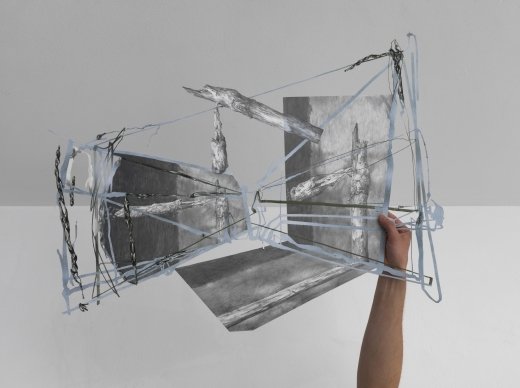Philip Loersch
dal 18/6/2009 al 30/7/2009
Segnalato da
18/6/2009
Philip Loersch
Galerie Jette Rudolph, Berlin
Bedingungen schaffen/ creating terms. Loersch's drawings and cut-outs occupies space, suspended from ceilings or tensioned in front of walls to suggest a visual three-dimensionality, but is in fact defined on the two-dimensional plane. They are characterized by graphic shade drafts and integrated into a seemingly logical structure of diagram-like meshes of threads.

“The geometrical mind is not wedded with geometry like that, thus separated one is being able to transfer it onto other domains/ fields of knowledge [...].”
(free translation: Bernard Le Bovier de Fontanelle*)
For his first Solo show entitled “Bedingungen schaffen/ creating terms” at the gallery Jette Rudolph in Berlin, Philip Loersch will present his latest and new drawings after his successful appearance at the Overbeck-Gesellschaft in Lübeck (Germany) in springtime this year.
Loersch ’s drawings and cut-outs occupies space, suspended from ceilings or tensioned in front of walls to suggest a visual three-dimensionality, but is in fact defined on the two-dimensional plane. They are characterized by graphic shade drafts and integrated into a seemingly logical structure of diagram-like meshes of threads. One of Loersch’s central themes is the element of water, captured and frozen on a constructive axial and radial system. Loersch limits his materials to lead pencil and green ink, plus white spray paint layered on polystyrene. The firmness of the medium allows the artist to cut out his motifs along the contours providing them with liveliness, corporeity and an illusion of motion.
His drawings bring to mind Turner ’s fantastic oscillating and vaporising light and wave reflections. However, in addition to its iridescent surfaces, light refraction and ambient colour, the rational construct of thought is invoked and hints at philosophical and scientific approaches. The artist refers i.a. to the classical definitions by Empedocles and Plato, also to Euclid’s geometry, in which the being, the source of life or the existence of life is reduced to a few prime matters and their interaction. They allocated regular mathematical solids to them, the so-called platonic solids, to represent their underlying essence, e.g. water = icosahedron -as if it is made of tiny little balls, when picked up water flows out of one’s hand. The blasted surfaces of the water gain a metaphorical sense by outlining the intangible matter of the element, and the fascination with the research for computability.
By using the technique of the cut-out Loersch leaves the familiar conditions of the two-dimensional image and generates an own system of psychology and association.
The concern of the artist is to show the character of nature, its complexity of process, conditions of rhythm and time by a kind of test set-up. This is exemplified in a static language of forms and signs. Thus his walk-in manner of cut-outs evoke an impression of skipping between two-dimensionality and three-dimensionality, motifs and their abstract as well as the mutability of conditions in a non-stable system.
*Preamble about the advantage of mathematics and natural sciences; ex: Technique philosophy from the ancient world to the present; ed.: Peter Fischer, Reclam Verlag Leipzig, 1996
Opening june 19th 2009 h 7p.m. - 10 p.m.
Galerie Jette Rudolph
Zimmerstrasse 90-91 - Berlin
open: Tues- Sat 11.30 am- 6 pm
free admission



